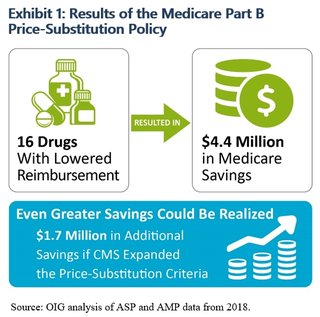Report Materials
WHY WE DID THIS STUDY
When Congress established average sales prices (ASPs) as the basis for Medicare Part B drug reimbursement, it also provided a mechanism for monitoring market prices and limiting potentially excessive payment amounts. Generally, Part B-covered drugs are those that are injected or infused in physicians' offices or hospital outpatient settings. The Social Security Act (the Act) mandates that OIG compare ASPs with average manufacturer prices (AMPs). If OIG finds that the ASP for a drug exceeds the AMP by a certain percentage (currently 5'percent), the Act directs the Secretary of Health and Human Services to substitute the ASP-based payment amount with a lower calculated rate. Through regulation, CMS outlined that it would make this substitution only if the ASP for a drug exceeds the AMP by 5 percent in the two previous quarters or three of the previous four quarters.
Over the last decade, OIG has produced annual reports aggregating the results of our mandated quarterly ASP-to-AMP comparisons. This latest annual report quantifies the savings to Medicare and its beneficiaries that are a direct result of CMS's price-substitution policy based on 2018'average sales prices. This report also provides support for a previous OIG recommendation for achieving additional savings.
HOW WE DID THIS STUDY
To determine the effects of the price-substitution policy, we determined the difference between ASP-based payment and AMP-based payment for each drug with a price substitution. We then applied this difference to the Medicare utilization for each of these drugs. To account for a three-quarter lag between the reporting of pricing data and applying price substitutions, we used drug utilization data for the fourth quarter of 2018 through the third quarter of 2019 to calculate the savings based on 2018 ASP data.
WHAT WE FOUND
- CMS lowered Part B reimbursement for 16 drugs on the basis of 2018 data.
- CMS's price-substitution policy saved Medicare and its beneficiaries $4.4 million over 1 year.
- Medicare and its beneficiaries could have saved up to an additional $1.7 million over 1 year if CMS implemented a more expansive price-substitution policy that allowed substitution for drugs that exceeded the 5-percent threshold in a single quarter.
WHAT WE RECOMMEND
OIG has previously recommended that CMS expand the price-substitution criteria. However, CMS did not concur with expanding the price-substitution policy and expressed concern that expanding price-substitution criteria may impede physician and beneficiary access to drugs. OIG agrees that access to prescription drugs should always be considered when contemplating pricing policies, and OIG supports current safeguards to prevent substitutions for drugs that the Food and Drug Administration has identified as being in short supply. However, OIG continues to believe that CMS can achieve a better balance between safeguarding access to drugs and ensuring that Medicare and its beneficiaries do not overpay for drugs.
CMS responded that it continues to not concur with our recommendation. CMS reported that, as additional data becomes available and as it continues to gain experience with the price substitution policy, it will consider further changes as necessary. CMS also stated that the current policy safeguards—which identify drugs that exceed the 5-percent threshold for two consecutive quarters or three of four quarters—identify drugs that consistently exceed the threshold.
Notice
This report may be subject to section 5274 of the National Defense Authorization Act Fiscal Year 2023, 117 Pub. L. 263.

